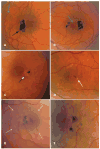The prevalence of macular telangiectasia type 2 in the Beaver Dam eye study
- PMID: 20609708
- PMCID: PMC2901890
- DOI: 10.1016/j.ajo.2010.02.013
The prevalence of macular telangiectasia type 2 in the Beaver Dam eye study
Abstract
Purpose: To examine the prevalence of macular telangiectasia type 2 and lesions characterizing it.
Design: Population-based cohort study.
Methods: setting: City and township of Beaver Dam, 1988-1990. study population: A total of 4790 people 43-86 years of age. observation procedure(s): Grading from stereoscopic fundus photographs to measure macular telangiectasia type 2. main outcome measure: Prevalent macular telangiectasia type 2.
Results: Macular telangiectasia type 2 was present at baseline in 0.1% of the population (95% confidence interval [CI] 0.09, 0.1). The frequencies of loss of retinal transparency, crystals in the inner retinal layers, blunted retinal vessels, localized intraretinal pigment migration in the juxtafoveolar region, and presence of yellow deposits and lamellar holes in the foveal area in those without macular telangiectasia type 2 varied from 0.06% for retinal telangiectatic vessels to 1.2% for lamellar holes. Smoking was associated with pigment clumping (odds ratio [OR] per pack year 1.02; 95% CI 1.00, 1.03; P = .02), retinal pigment epithelial (RPE) depigmentation (OR 1.02 per pack year; 95%CI 1.00, 1.04; P = .02), loss of transparency (OR 1.02 per pack year; 95% CI 1.00, 1.03; P = .008), and the presence of a yellow spot in the fovea (OR 2.24 current vs past or never smoker; 95% CI 1.29, 3.89; P = .004), but not with presence of macular telangiectasia type 2 (OR 2.72; 95% CI 0.45, 16.28; P = .27).
Conclusions: The prevalence of macular telangiectasia type 2 (0.1%) is higher than previously thought. These data are useful in estimating the burden of this condition in the population. The role of smoking in the development of macular telangiectasia type 2 requires further study.
2010 Elsevier Inc. All rights reserved.
Figures



References
-
- Gass JD, Blodi BA. Idiopathic juxtafoveolar retinal telangiectasis. Update of classification and follow-up study. Ophthalmology. 1993;100:1536–1546. - PubMed
-
- Abujamra S, Bonanomi MT, Cresta FB, Machado CG, Pimentel SL, Caramelli CB. Idiopathic juxtafoveolar retinal telangiectasis: clinical pattern in 19 cases. Ophthalmologica. 2000;214:406–411. - PubMed
-
- Yannuzzi LA, Bardal AM, Freund KB, Chen KJ, Eandi CM, Blodi B. Idiopathic macular telangiectasia. Arch Ophthalmol. 2006;124:450–460. - PubMed
-
- Chew E, Gillies M, Bird A. Macular telangiectasia: a simplified classification. Arch Ophthalmol. 2006;124:573–574. - PubMed
-
- Gupta V, Gupta A, Dogra MR, Agarwal A. Optical coherence tomography in group 2A idiopathic juxtafoveolar telangiectasis. Ophthalmic Surg Lasers Imaging. 2005;36:482–486. - PubMed
Publication types
MeSH terms
Grants and funding
LinkOut - more resources
Full Text Sources
Medical
Miscellaneous

